I'm sure many modelers are interested in the differences between R35 kits from Tamiya, Aoshima and Fujimi, so here I present you a brief review of those kits.
I have some other projects to finish, so the actual progress will be slow, but I should be able to answer to any questions in regards to the content of the kits.
Keep in mind that photographs are NOT a good reference when nitpicking details, because of lens distortion and photographing environment play a major role in fooling your eyes. I did use a tripod, but each model wasn't placed on a marked position or a jig.
I obtained the R35 body repair manual, which details the dimensions of the actual car. After quick measuring, all three bodies are fairly accurate, and the margin of error is less than 1.0mm. The only exception is Tamiya. The body is wider by approximately 1.0 mm both sides, compared to Aoshima or Fujimi.
< Front View >
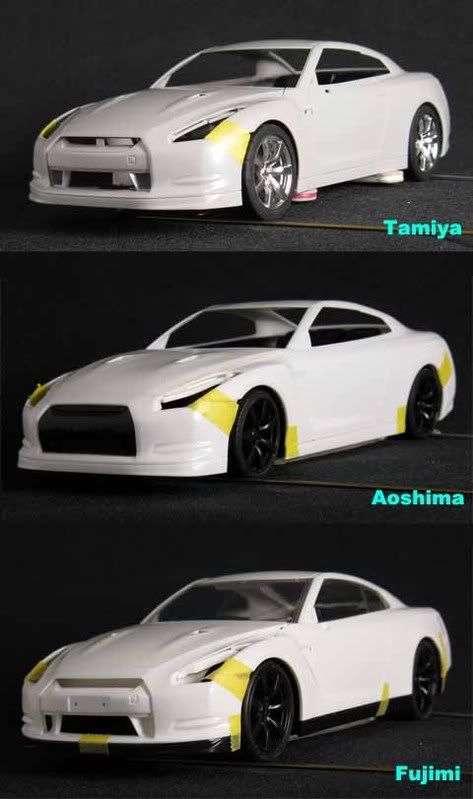
Tamiya body is made of the main shell, front bumper and hood, and they all fit well, but requires some masking.
Aoshima made the front and rear bumpers separate, as well as the rocker panels, hood, and the grill. This kit is the Premium version, and the body of the standard version (Best Car GT No.28) is modled in grey. Aoshima's rear bumper is deformed from cooling, but it can be corrected by careful bending. The back side of the hood need to be sanded for the part to sit on the body properly. The separate grill makes painting easier than Tamiya or Fujimi.
Fujimi did every exterior panel separate, including the hood, front and rear bumpers, front and rear lip spoilers, rocker panels and hood. Fujimi also shows good attention to details, by opening only the right side (driver side in JDM) of the lower part of the grill, which channels air to the oil cooler. (Located on the opposite side is the washer fluid tank, so no need for an air intake.) Fitting of exterior parts is perfect, but gluing may be tricky to the beginners because the joining surfaces are a bit small.
< Rear View >
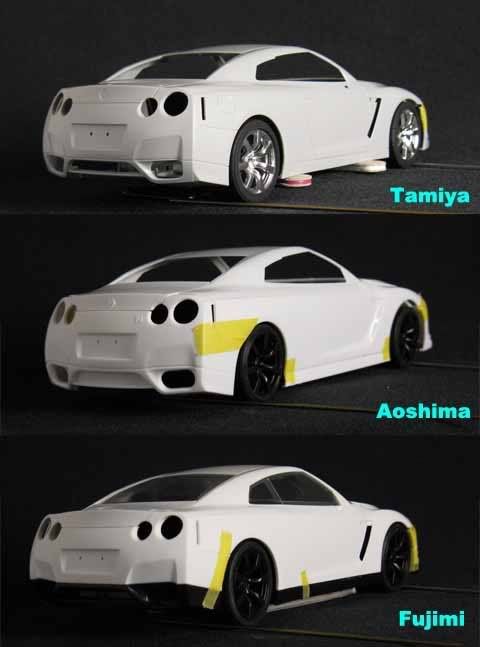
Looking at the back of actual models, Tamiya seems wider, while Aoshima seems narrower, and Fujimi is in-between. They all look like the GT-R, and I don't think bodies aren't going to be a deciding factor of which to buy. Tamiya and Aoshima kits come with four-piece rear wring, while the Fujimi includes an additional clear part for the brake light.
< Suspension and Brakes >

Suspension and brake details are where Fujimi outshines the competition. Tamiya's suspension parts fit well, but look just okay. As always, caliper and rotor are molded together, and the rotor doesn't even have ventilation holes, demanding you to buy the PE parts.
Aoshima made the rotor separate (for the first time, IIRC), and the joining surface is large enough, so putting the caliper parts together won't be so hard. With Aoshima, lowering the ride height requires no modification to the kit parts. All you have to do is to add a washer to the lower control arms, something a first-time modeler can do.
Fujimi did some incredible job for the kit price of 2800 yen. The rotor is two-piece assembly, and it's got circular scratches molded on the surface! The calipers look gorgeous, and it even has two pins that fix the brake pad retainer. I've noticed that each rotor doesn't sit in the middle of the caliper (because the pads are not molded), so I suggest that you scratchbuild a washer of appropriate thickness. and insert it between the upright and rotor to fix this problem. This will also adjust/correct how deep each tire sits in relative to the body panel, so make sure you dry fit these parts.
< Chassis >
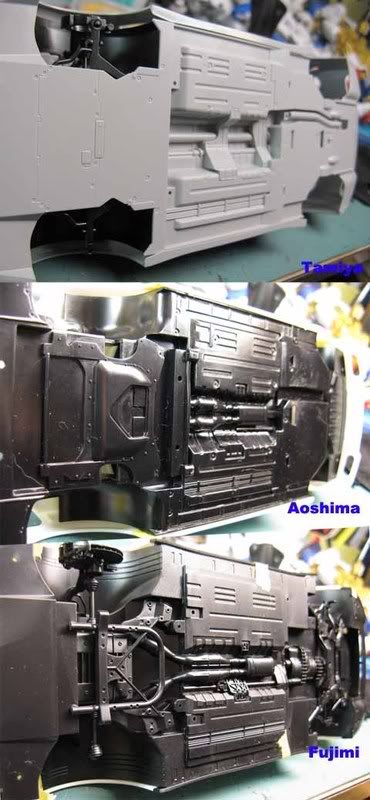
Tamiya and Aoshima chassis are moderately detailed, and easy to build. Fujimi includes front and rear sub-frames, so they are far more enjoyable to build even though they will be hidden.
< Interior >
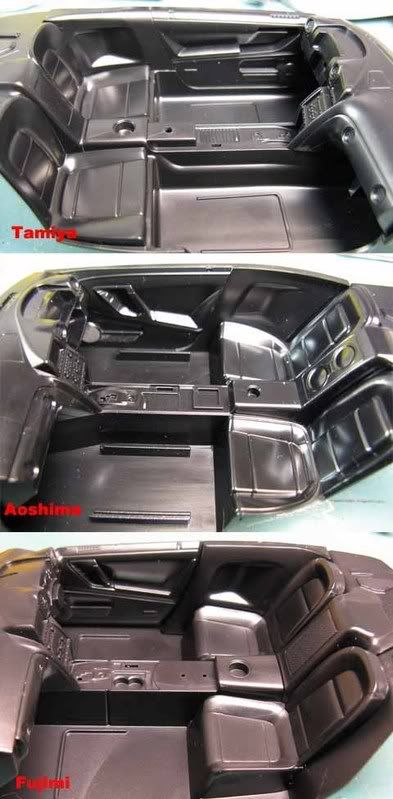
Only Tamiya gives the choice of right and left hand dashboard (and corresponding wiper parts), while Aoshima and Fujimi are right-hand only. In the past, Aoshima marketed LH steering kits (such as RX-7 and Z33), so we might see such variation someday. All three kits have separate side panels with good three-dimensional details. Tamiya includes chrome plated door handle, but the door panel seems elongated and inaccurate. Aoshima features nicely-molded speakers for Bose premium sound system.
< Dashboard >
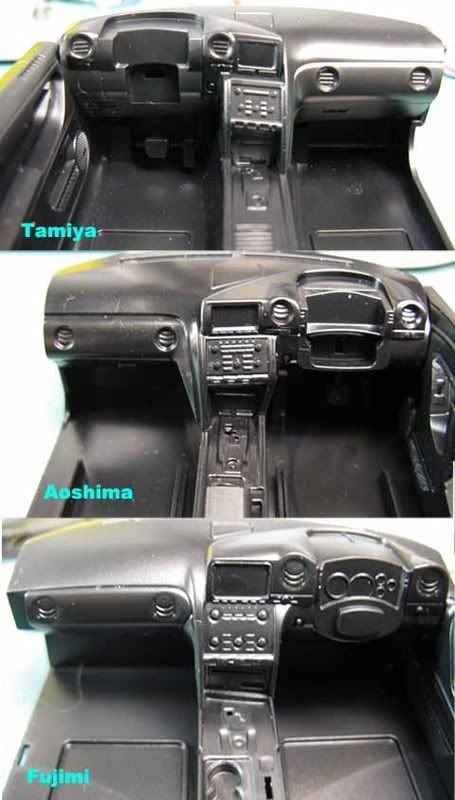
Tamiya's dashboard is least detailed, and the dimensions of the display and center control panel are inaccurate. The pedals don't have any details, because the separately-sold PE set does.
Aoshima seems most accurate, except for the height of the display.
Fujimi doesn't seem bad, but the gauge panel should be pushed in further.
Decals are provided in each kit, but Fujimi's multi-function display is "turned off", meaning no decal for it.
< Seat and Interior Misc. >

Although not pictured here, seats are another turn-on, turn-off factor. Tamiya's seat is thin and narrow, but the bottom element is separate, allowing you to choose either the RH or LH configuration.
Aoshima seat is two piece design, which includes a separate back panel.
Fujimi's seat is three-piece assembly, and looks most accurate. Interesting feature of Fujimi interior is the separate center and backsupport in the rear. You can to add a gigantic amp and speakers, without removing the seat details on the kit part.

< Wheel & Tire >
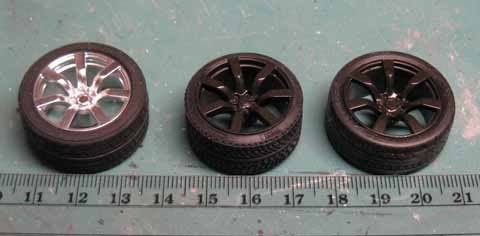
The diameters of Tamiya and Aoshima wheels are accurate, while Fujimi wheel is 1 scale inch bigger (exactly what their "inch-up" series kits should have). Tamiya tires look nice, but too wide to my taste. It doesn't have any logo either.
Aoshima's tire profile is too low, making the overall diameter too small. The brand is Pirelli P7000, which is not correct, but at least it's not a generic low-speed tire.
Fujimi tires are deliberately low-profiled to match the kit's "inch-up" theme, but the overall tire/wheel diameter is kept accurate, so it odoesn't affect the ride height. Each tire has Bridgestone and Potenza logos on both sides, as well as the tire size designation, but both sides have the lettering "outside." (LOL)
< Decals + extra >
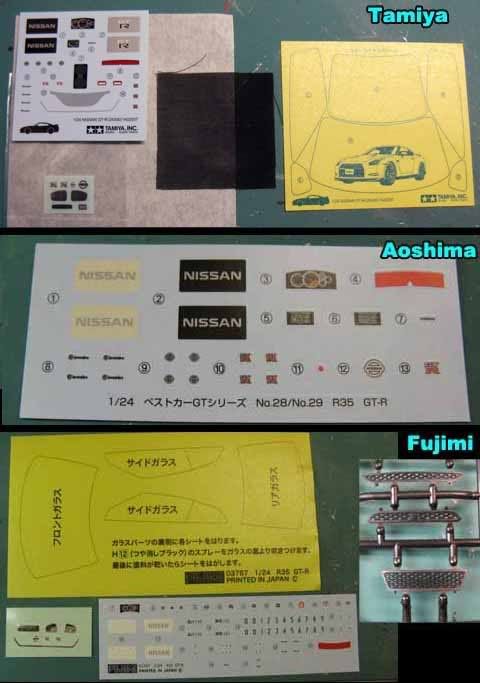
Tamiya's misc. bag includes decals, metal transfers, nylon mesh and pre-cut window masking adhesives.
Aoshima kit doesn't come with any nifty extra, but all the necessary decals are provided. My kit includes another sheet of decals, and apparently, it was because the red on the other sheet was slightly mis-aligned. Good thing, Aoshima corrected the error.
Fujimi's offering is comparable to Tamiya's. It comes a sheet of decals, which includes all the Japanese registration stickers and license plates with individual letters and numbers. Instead of a nylon mesh you find in the Tamiya kit, Fujimi molded the corresponding parts see-through, which is becoming a Fujimi standard--good practice to satisfy both the budget-conscious and detail-oriented modelers.
< Metal Transfer >

Tamiya and Fujimi's metal transfers include mirror faces, GT-R badges, and Nissan badges. Tamiya has an extra Nissan badge for the top of the engine, while the Fujimi includes the chrome trim on the bumper. "NISSAN" decal that goes on the badge is provided in both kits.
Aoshima's GT-R and Nissan badges are molded on the body. You can also see how Aoshima represented the mesh.
< Conclusion >
So, which kit design would you prefer--precise Tamiya, simple Aoshima, or detailed Fujimi?
My pick is
Fujimi, for
accuracy and overall
value of the kit.
Here's a my quick compatibility list. I hope it helps you determine which kit suits your need.
Buy Tamiya if you...
...have lots of money.(3800 yen + 1365 extra for PE & exhaust tip)
...want left-hand steering.
...want engine details (regardless of the level of detail).
...prefer a wider body (approx. +2.0mm).
...prefer wider tires (F:+2.8mm, R:+1.7mm)
Buy Aoshima if you...
...are budget conscious.(2800 yen)
...prefer fewer parts for simple / faster building.
...want to lower the ride-height effortlessly.
...are going to replace the wheels/tires.
...can live with decals instead of metal transfer
Buy Fujimi if you...
...are budget conscious.(2800 yen)
...are detail conscious.
...know the basics of cleaning and dry-fitting parts.
...prefer many parts for more fulfilling pleasure of building.
...prefer the "inch-up" appearance of the stock wheel (21 scale inch)
...prefer better looking tires with Bridgestone and Potenza logos.
< Reference (Wheel & Tire dimensions in millimeter) >
Real Car
Wheel:
(F) 20 x 9.5J (22.7 x 10.1 w/ 18mm flange)
(R) 20 x 10.5J (22.7 x 11.1 w/ 18mm flange)
Tire:
(F) 255/45ZRF20 (tire width/dia: 10.6/approx: 30.7)
(R) 285/35ZRF20 (tire width/dia: 11.9/approx: 29.5)
Tamiya
Wheel Dia: 23.0 (F,R) Error: negligible
Tire Dia: 30.5 (F,R) Error: negligible
Tire Wid: 12.3 (F) +1.7
Tire Wid: 13.7 (R) +1.8
Aoshima
Wheel Dia: 23.0 (F,R) Error: negligible
Tire Dia: 27.8 (F,R) -2.9/-1.7
Tire Wid: 12.3 (F) +1.7
Tire Wid: 13.0 (R) +1.1
Fujimi
Wheel Dia: 23.8 (F,R) +1.13mm
Tire Dia: 30.5 (F) Error: negligible
Tire Dia: 30.7 (R) +1.2
Tire Wid: 10.5 (F) Error: negligible
Tire Wid: 12.0 (R) Error: negligible